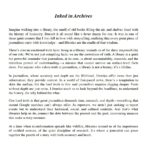Navya Sharma
Imagine walking into a library, the smell of old books filling the air, and shelves lined with the history of humanity. Doesn’t it all sound like a fever dream for one. It was in one of these quiet corners that I first fell in love with storytelling, realising that every great piece of journalism starts with knowledge—and libraries are the cradle of that wisdom.
There’s also an emotional truth here: being in a library reminds us of the sheer responsibility of our role. We’re not just compiling facts; we are the custodians of truth. A library is a quiet but powerful reminder that journalism, at its core, is about accountability, research, and the relentless pursuit of understanding—a mission that cannot survive on surface-level facts alone. For anyone who values truth in journalism, a library is not a luxury; it’s a lifeline.
In journalism, where accuracy and depth are the lifeblood, libraries offer more than just information; they provide context. In a world of fast-paced news, there’s a temptation to skim the surface, but the hard truth is this: real journalism requires digging deeper. Facts without depth are just noise. Libraries teach us to look beyond the headlines, to understand the history, the why behind the what.
One hard truth is that great journalism demands time, research, and depth—something that instant Google searches can’t always offer. As reporters, we aren’t just seeking to report events but to understand their historical, social, and cultural contexts. And that’s what libraries help us do, connect the dots between the present and the past, uncovering nuances that make a story resonate.
At a time when misinformation spreads like wildfire, libraries remind us of the importance of verified sources, of the quiet discipline of research. It’s where a journalist can piece together the puzzle of a story with both accuracy and heart.




No responses yet